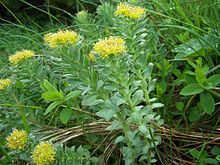Rhodiola rosea
| Rhodiola rosea | |
|---|---|
 |
|
| Scientific classification | |
| Kingdom: | Plantae |
| (unranked): | Angiosperms |
| (unranked): | Eudicots |
| (unranked): | Core eudicots |
| Order: | Saxifragales |
| Family: | Crassulaceae |
| Genus: | Rhodiola |
| Species: | R. rosea |
| Binomial name | |
|
Rhodiola rosea L. |
|
| Synonyms | |
Rhodiola rosea (commonly golden root, rose root, roseroot,western roseroot, Aaron's rod, Arctic root, king's crown, lignum rhodium, orpin rose) is a perennial flowering plant in the family Crassulaceae. It grows naturally in wild Arctic regions of Europe, including Britain, Asia and North America, and can be propagated as a groundcover. Although it has long been used in traditional medicine for several disorders, notably including treatment of anxiety and depression, there is little scientific evidence to verify these uses.
Rhodiola rosea is from 5 to 40 centimetres (2.0 to 15.7 in) tall, fleshy, and has several stems growing from a short, scaly rootstock. Flowers have 4 sepals and 4 petals, yellow to greenish yellow in color sometimes tipped with red, about 1 to 3.5 millimetres (0.039 to 0.138 in) long, and blooming in summer. Several shoots growing from the same thick root may reach 5 to 35 cm in height. R. rosea is dioecious – having separate female and male plants.
The first time that R. rosea is described was from Dioscorides in De Materia Medica.
Western North American plants formerly included in R. rosea are now treated as Rhodiola integrifolia and Rhodiola rhodantha.
R. rosea grows in cold regions of the world, including much of the Arctic, the mountains of Central Asia, scattered in eastern North America and mountainous parts of Europe. It grows on sea cliffs and on mountains at high altitude.
The leaves and shoots are eaten raw, having a bitter flavor, or cooked like spinach, and are sometimes added to salads.
In Russia and Scandinavia, R. rosea has been used for centuries to cope with the cold Siberian climate and stressful life. It is also used to increase physical endurance and resistance to high-altitude sickness, but the scientific evidence for such benefits is weak. The plant has been used in traditional Chinese medicine, where it is called hóng jǐng tiān.
...
Wikipedia
